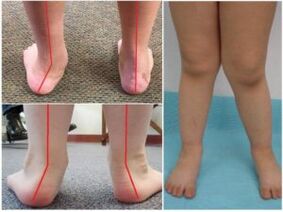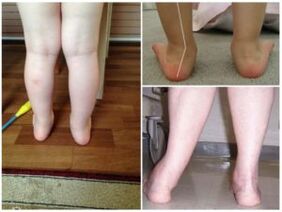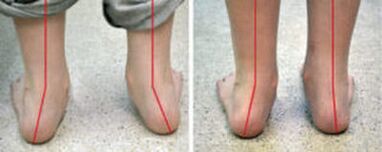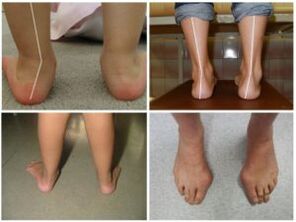The parents have to pay great attention to their children's physical development in order to adapt the defects in good time.The valgus deformation of the foot in children is a common pathology.Although the defect is innate or acquired, diagnosis, prevention and correction methods are similar.
What is a valgus and flat-valgus foot

The term valgus doctors refer to any curvature of connections inside the conditional center line (axis), in which an excellent "x-shaped" deviation can be felt.The most pronounced example of pathology is the bones on the thumb (Hallux Valgus).Valgus deformation, which is abbreviated as a "valgus foot" (sun), is the wrong assumption of the foot on the horizontal support.When the one -year -old baby summarizes the legs, the back is noticeable because the inner ankle changed closer to the opposite limb and the heel deviated on the outside.At the same time, a flat child is mainly based on the inner (media) part of the foot.Therefore, the plantar region looks "out", so to speak.A large number of disease is a flat valgus foot (PVS).It combines flat feet with an X-shaped curvature.In addition to the formation of the deformation, the foot set is gradually flattering.
The degree of Valgus curvature
The stage of neglecting the pathology is determined by the size of the deviation angle of the heel from the middle axis.
There are 4 degrees of illness:
- I - up to 15 °;
- II - 15 word °;
- III - 20º29 °;
- IV - 30 ° or more.
1-2 stage of valgus deformation can be eliminated using conservative methods.Longer treatment is required at 3 degrees.Surgical correction may be required in 4 stages.
The causes of the deformation
There are three factors, which is why there is a curvature of the foot: impaired intrauterine development, chronic physical overload, diseases of the musculoskeletal system.These factors weaken the ligaments, tendons, muscles, so that the foot is not fixed by them in a normal anatomical position.
The reasons for the acquired valgus, flat-valgus foot (code M21.0 in ICD-10):
- Early setting on the legs when the babies' joints are not yet ready for such loads;
- "False" shoes (narrow block with a thin high heel without supinators).
- Muscle hypotension, innate myodistrophy;
- Great weight, obesity;
- Rickets;
- Neuromuscular diseases (polio, brain paralysis of children, polyneuropathy of different etiologies);
- Congenital transfer of the thigh and the dysplasia of the hip joints;
- Trauma for foot or lower leg;
- Long -term realmobilization of the leg with plaster, tutor or pillow from Freik.
The congenital origin of the valgus and flat valgus defect in the structure of the foot (Q66.6 code in ICD-10) can be attributed to a violation of the abdomen or genetic illness transmitted by a pregnant woman.Such a curvature can be seen immediately after birth, sometimes she manifests herself before the baby begins.
How to determine the deformation of the stop

A change in the configuration of the lower limb is set along the axis of the leg.This is the name of the conventional line, which is visually pulled from the middle of the hip joint through the knee, ankle to the middle of the calcaneus.The standard implies the passage of the axis through the middle of the joints, which should not be moved to the right or left.
Characteristic features
In newborns, it can be found immediately or in the first months of life with the innate nature of Valgus.Signs of a valgus defect in children appear most frequently after one and a half years.The presence of the disease can be assumed by the behavior and course of the baby.The following general symptoms of pathology are mostly found:
- increased flexibility of small joints;
- Acceptance of the sole's set;
- The shift of the focus (to go on an attempt can only be dependent on the medial side of the foot, its outer edge can rise slightly);
- uncertain, mixing gait;
- Fast physical fatigue, the need for calm to give the baby to relax;
- Regular symptoms of pain in the legs to run a lack of willingness;
- Sluming of light and redness of the skin in the foot and on the ankle;
- Uneven wear of shoes, more expressed from the inner edge of the sole.
Methodology to identify the deformation
Defect diagnostic methods include an investigation with an orthopedics of the foot foot, followed by the direction of the baby for instrumental examination.It is made into an X feet in three forecasts to find out the degree of bone shift.They also carry out planetography to determine the amount of enthusiasm and the severity of the flat feet.The printing center on the sole is calculated with the mail meter.This is an effective diagnostic method because they can identify valgus deformations in the early stages.Sometimes an ultrasound of the foot is made to clarify the results of the exam.The visual signs of the pathology are the sole, which is turned slightly and in a lateral direction, the shift of the heel, raised from the middle line.In the case of a flat valus deformation, the disappearance of the vault, the flattening of the foot flattened, is noted.In order to rule out the neurological causes of the defect, the orthopedist leads the child to a narrow specialist.
Correction methods
In order to remove valgus, the main tasks must give the foot of the correct position and the subsequent strengthening of the ligaments attached to the heel and muscle damage.
Fixing the joint in a conservative way
Gypsum associations or tutors are used with an innate defect.The purpose of staring the foot at the right angle is to eliminate the curvature by immobilization.While the ossification is not complete, the fabrics are elastic, so they are easily accessible for such a correction.With the acquired valgus defect, orthopedic shoes are carried out to the child in order to return the correct setting of the foot.It should not cause discomfort when used.A special shoe insole has side stiff supercinators, a soft pillow (pelot) under the foot of the foot.It is also recommended to carry such shoes during rehabilitation after the operation and to consolidate the treatment results.
A variety of insoles with valgus foot
Experts recommend ordering orthoses, shoes or insoles for children in orthopedic salons in accordance with the individual sizes and foot degrees.The product price will be somewhat higher, but the use provides a more noticeable result.
Strengthening small joints

For general hardening and tonic muscles of the lower extremities, it is recommended to use contrasting foot baths.To do this, the feet are dipped alternately in a container with cold and hot water.They start with a temperature of 36 ° C with a liquid, this value is changed by 1 ° C every week, which gradually leads to an area from 14 to 40 ° C.
It is useful to carry out the following exercises:
- Alternatives go on socks, heels, inner, outer edges of the sole;
- Collect small objects, steal fabric or paper, draw with your feet;
- Send the bullet sole on the floor;
- a number of exercises for the fingers (bend, breeding and closing);
- Go on pebbles and an uneven surface.
The Orthopäler can prescribe a massage course of the lumbar spine, which is affected by the lower extremity or both legs.It is optimal to carry out it with paraffin or ozokeritic application after heating.The muscles of the inner surface of the legs are caused by tonic massage movements (knocking, kneading).The outer surface of the legs should be massaged with relaxing techniques - stroke, rub.
Physiotherapeutic methods
If the deformation of the foot caused inflammation of the joint structures, tendons of the muscles, the child is prescribed electrophoresis with pain relievers and anti -inflammatory medication, magnetic therapy, use of black wax, paraffin and therapeutic mud.Dianamic currents are used for selective muscle stimulation.
Surgical treatment
No radical therapy methods are used in early childhood.But if the defect affects normal walking, the operation is carried out to small children.During the surgical intervention, doctors who use metal elements (titanium wire, screws, plates) attach a deformed joint in a normal position.Surgeons can also strengthen the joint by moving the fibula tendon or extending the Achilles tendon.After these operations, rehabilitation includes the use of orthopedic products, massage, physiotherapy and physiotherapy exercises.
Preventive measures
To prevent the valgus deformation of the foot, you have to buy a child -famous shoes that corresponds to the size of the leg, the anatomical structure of the foot.How to select - Watch the recommendations from E.O.Komarovsky in the video.The doctor says of the illness that this is a common injury to children and helps to correctly form the foot up to the age of 12.The teenager most likely needs an operation to correct the pronounced foot defect.The child should go barefoot on sand, grass, go a lot, eat fully.The dosed sunbathing prevents rachitis in children, which is one of the causes of the disease.Sports lessons, hardening of the body, regular courses of the general strengthening of the massage.The gymnastics for the foot muscles are also important, including the creation of a leg pattern in the sand.Active outdoor games also contribute to strengthening the muscles and ligaments of the lower extremities.All of these measures prevent the development of foot defects.It is forbidden to put on the child's legs up to 7.5 gra p .8 months if the joints and bones of the lower extremities have not yet been strengthened.It is not acceptable to miss the planned exams of the pediatrician and the tight specialists who enable them to identify the pathology at an early stage.
Answers from the doctors to the parents' questions
How do you warn the congenital valgus deformation?Unfortunately, the trucks of the development of the musculoskeletal system cannot be prevented.Even if there were no deviations in the hospital, the baby should be regularly inspected by a pediatrician, get massage, barefoot on an uneven but safe surface for legs.At home it is recommended to use a massage carpet.The acquisition of high quality shoes also helps to bring your foot into the right position and to form a number of physiological heights.Such prevention will stop progress even congenital valgus foot.
Which doctor treats pathology?
If necessary, the pediatrician leads the baby to the child orthopedist, the traumatologist, surgeon.
What is a Variorfuss?
Varus deviations are the shift of the heel bone from the center line.In this case, the foot set becomes very high and the middle of the pressure is moved to the outer edge of the sole.A defect is treated with the same methods as valgus deformation, only the deviation angle is set from the opposite side of the foot.
Valgus deformation of the foot in children: consequences and correction
The valgus deformation of the foot is a pathological change in the musculoskeletal system in which the height of the foot set decreases, and the axis of the lower extremities changes.
The defect can be innate or develop in childhood, which leads to flat feet, violation of attitude and other health problems.As a rule, it is conservatively adjusted in the course of a long therapy with load, massages and physiotherapy.With regular work on deformation, you can achieve the proper adjustment of the leg and self -confident gear.
Flach valgus deformation of the feet in children's symptoms
This leg error can be recognized using the following external signs:
- The foot is littered with the inner rib, the child rests on the inner part of the foot;
- The heel and fingers are used externally;
- The middle part of the foot is flat or noticeably reduced;
- If the knees are reduced, the legs acquire an IX brow form, the legs do not converge, the distance between around 4 to 5 cm preserved between them;
- Uncertained, awkward gait, the child was often stuck, shuffle;
- The child quickly gets tired on a walk.

When can a defect manifest itself?
The foot arch begins from the moment the baby tries to take the first steps.A flat foot is considered the norm for infants.When children take a vertical position independently, the children develop a musculoskeletal system, "get used to" it on new functions.Bones and ligaments begin to experience loads, the foot is strengthened and has the right anatomical shape.This usually happens up to 1.5 years.If the vaults remain flat at this age, the doctors define this as a valgus deformation of the foot.As a rule, violations of medical examinations are found, but if the parents have noticed the above signs independently, they must immediately contact an orthopedics.If you start setting as early as possible, restoration is faster and without serious consequences.
Diploma
Parents must devote the maximum time of prevention of defects in the physical development of the baby, including gymnastics, massage courses and other leisure activities.If the valgus deformation of the foot in children is not eliminated by conservative treatment, you must agree to the surgical intervention to correct the shape of the foot.After all, the advanced pathology with the development of osteoarthritis, spine diseases and the shortening of the limb is freed.

























